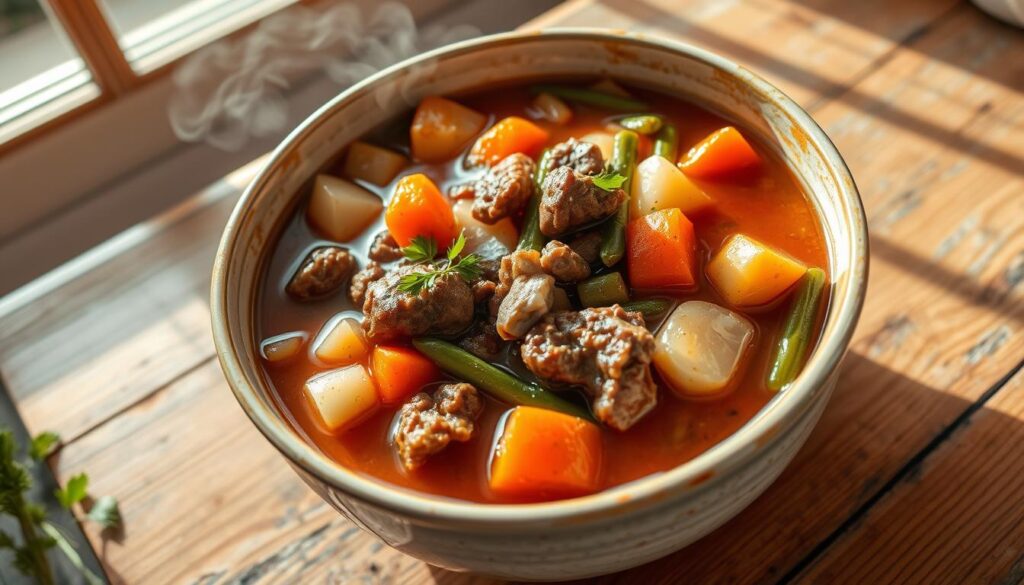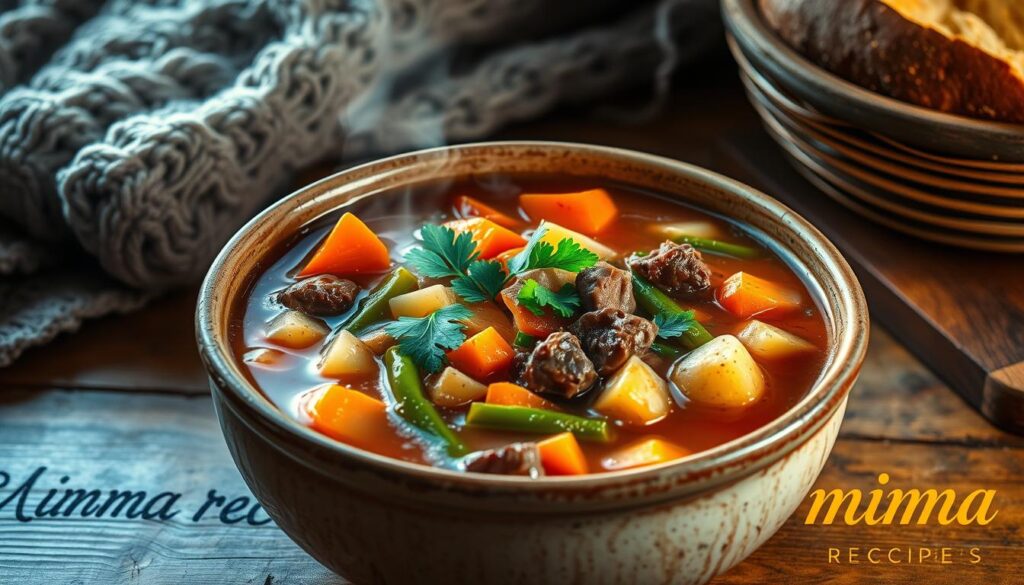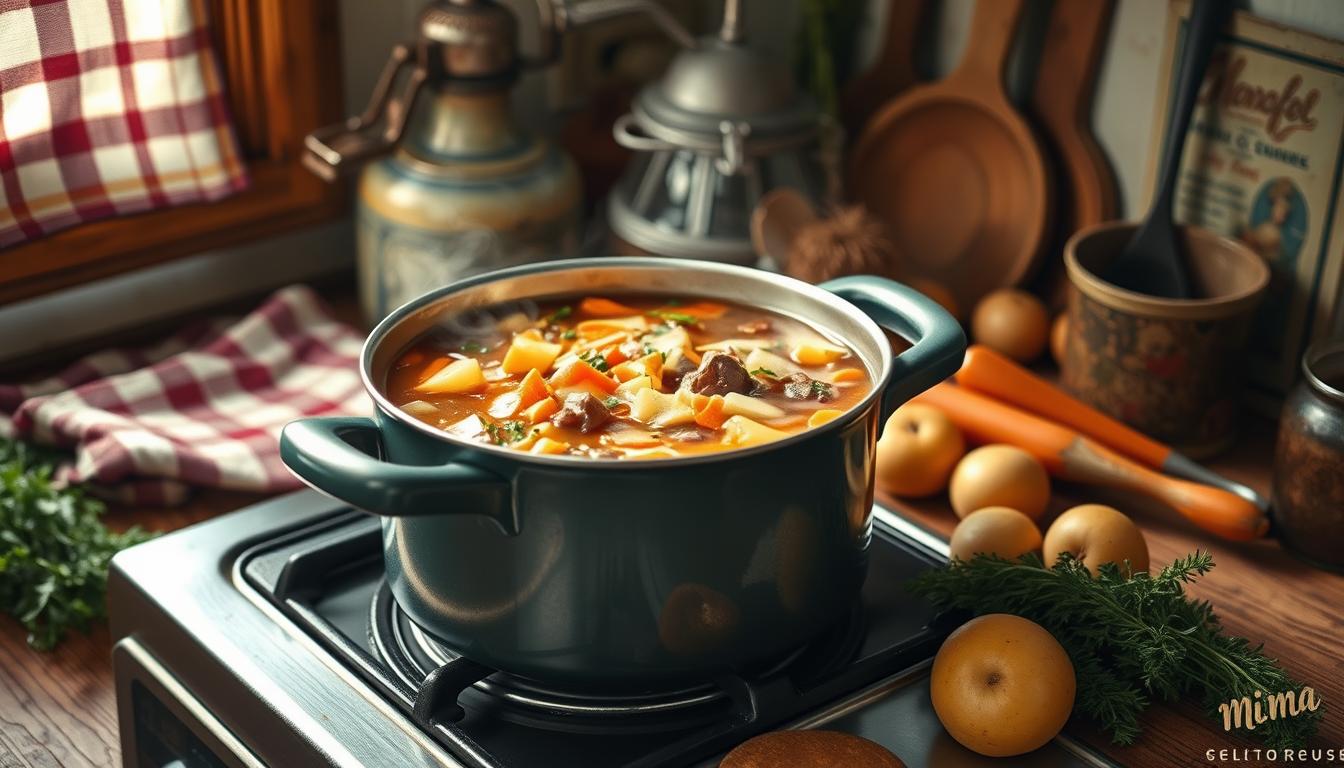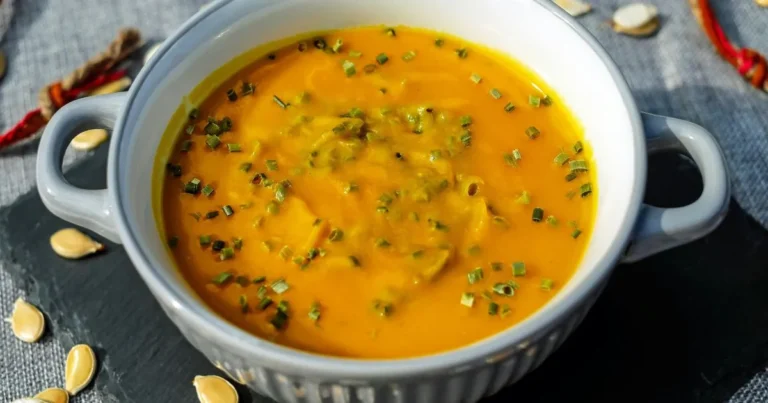Comforting Old Fashioned Vegetable Beef Soup Recipe: A Traditional Family Favorite
Experience the warmth and nostalgia with our old fashioned vegetable beef soup recipe. It’s perfect for cold days, nourishing and bringing back family memories. This soup combines tender beef, wholesome veggies, and a rich broth, making it a classic at home.
Whether you use fresh or frozen veggies, this soup is both versatile and delightful. It’s a true family favorite.
Table of Contents
The History Behind Old Fashioned Vegetable Beef Soup
The classic vegetable beef soup is more than a meal; it’s a trip through time. It shows the love and care of generations. This dish has been a favorite in American homes, bringing nostalgia with every spoonful.
Origins of This Classic Recipe
Long ago, when farming was key, this soup came from using what was available. It used root veggies, tender beef, and herbs for a filling meal. Families loved it, and each region added its own twist, keeping the classic vegetable beef soup alive.
Why It Remains a Family Favorite
This soup has lasted because it’s comforting and can be made in many ways. It brings families together, creating special moments. The nostalgia vegetable beef soup connects us to our past, reminding us of the joy of homemade meals.
Traditional Ingredients Through the Ages
The main ingredients of the classic vegetable beef soup have changed a bit over time. But the heart of it remains the same. Traditional parts include:
- Beef stew meat
- Root vegetables like carrots and potatoes
- Celery and onions for flavor base
- Tomatoes, peas, and corn
- Herbs like bay leaves and parsley
Today, we might add seasonal veggies to make it even healthier. This keeps the vintage vegetable beef soup tradition alive.
Essential Ingredients for Your Hearty Soup
Making the best vegetable beef soup begins with top-notch ingredients. For a classic soup, you’ll need fresh veggies, quality beef, and tasty seasonings. Here’s what you’ll need:
- Beef: 2 pounds of flank steak (or substitute with 2 pounds of ground beef)
- Soy Sauce: 2 tablespoons
- Vegetable Oil: 4 tablespoons total (1-2 tablespoons for sautéing mushrooms, onions, and beef)
- Mushrooms: 16 ounces
- Yellow Onion: 2 cups
- Garlic: 6 cloves
- Tomato Paste: 2 tablespoons
- Red Wine: 1/2 cup
- Low Sodium Beef Broth: 48 ounces
- Better than Bouillon Beef Flavor: 1.5 tablespoons
- Worcestershire Sauce: 2 teaspoons
- Fresh Thyme: 1 teaspoon
- Bay Leaves: 2
- Petite Diced Tomatoes: 2 cans (14.5 ounces each)
- Russet Potatoes: 2 large, cubed
- Carrots: 4 medium, cubed
- Celery Stalks: 2, cubed
- Frozen Green Beans: 1 cup, thawed
Choosing fresh, seasonal veggies will make your soup taste amazing. These ingredients make the soup rich and flavorful.
Here’s a handy table for the nutritional information of this classic vegetable beef soup:
| Nutrition per Serving | Amount |
|---|---|
| Calories | 486 kcal |
| Carbohydrates | 36 g |
| Protein | 43 g |
| Fat | 17 g |
| Saturated Fat | 10 g |
| Cholesterol | 90 mg |
| Sodium | 1,103 mg |
| Potassium | 2,297 mg |
| Fiber | 5 g |
| Sugar | 11 g |
| Vitamin A | 7,075 IU |
| Vitamin C | 15.9 mg |
| Calcium | 102 mg |
| Iron | 4.3 mg |
With these ingredients, you’re ready to make the ultimate vegetable beef soup. It will delight everyone with its hearty flavor.
Choosing the Perfect Cut of Beef
Choosing the right cut of meat is key to making the best vegetable beef soup. The perfect cut adds flavor and texture, making your soup rich and comforting.
Best Beef Cuts for Soup
For a hearty soup, pick cuts that are tender and flavorful. Chuck roast is a great choice because it’s marbled. This marbling melts, adding deep, beefy flavor to your soup.
Beef shank is another excellent option. Its bone adds richness to the broth, making your soup even more comforting.
Budget-Friendly Options
Looking to save money? Try using beef stew meat. It’s tougher, but slow cooking makes it tender and flavorful. Ground beef is also affordable and cooks quickly, in about 1 hour and 25 minutes.
Tip: Slow cooking or simmering your soup for 1.5 to 2 hours is best. It lets the flavors mix well and tenderizes the beef.
Preparing Your Meat
Before adding meat to your soup, prepare it well. Searing beef cubes before cooking adds a rich flavor. For example, searing 1.5 pounds of chuck roast into ¾” cubes locks in juices and boosts flavor.
Choosing the right cut, like chuck roast or a budget-friendly option, makes your soup delicious. It also fits your cooking style and budget. Your vegetable beef soup will be a hit with your family.
Fresh vs. Frozen Vegetables: Making the Right Choice
Choosing between fresh and frozen vegetables is key when making your easy vegetable and beef soup. Each option has its own benefits, depending on your cooking style and preferences.
Fresh vegetables usually have better texture and taste. They are best for those who want the most flavor. Seasonal veggies make your soup more nutritious and flavorful. Plus, buying fresh supports local farmers.
Frozen vegetables, though, are super convenient. They’re frozen at their peak, keeping taste and nutrients intact. Frozen peas and green beans are great for your soup, saving time and keeping flavor and texture good. They let you enjoy all veggies all year, no matter the season.
| Aspect | Fresh Vegetables | Frozen Vegetables |
|---|---|---|
| Flavor | Often more vibrant and aromatic | Consistently good due to peak freezing |
| Texture | Better firmness and crunch | Slightly softer but acceptable |
| Convenience | Requires washing and chopping | Pre-washed and pre-cut |
| Availability | Seasonal; might not always be available | Year-round availability |
| Nutrition | High during peak seasons | Preserved at peak freshness |
It’s up to you to decide. Both fresh and frozen veggies can make a tasty and healthy soup. Your choice should match your needs for taste, ease, and availability. This way, your soup will always be a hit with your family.
Step-by-Step Old Fashioned Vegetable Beef Soup Recipe
Making easy vegetable beef soup from scratch is rewarding. Follow this guide to enjoy the savory flavors of this classic dish.
Preparing the Base
Start by searing 2 pounds of cubed beef stew meat in a large pot over medium heat until browned, about 10 minutes. Remove the beef and set it aside. In the same pot, cook 8 ounces of chopped bacon until it’s crisp and brown, about 8-10 minutes. You can add 2 tablespoons of olive oil for extra richness.
Next, add two medium-sized, small-diced yellow onions and three thinly sliced leeks (white part only). Sauté until the onions and leeks caramelize, which takes about 30-35 minutes. Add four finely minced garlic cloves for more depth.
Adding Vegetables
Now, add the hearty vegetables to your base. Include three medium-diced carrots, three medium-diced celery stalks, one medium-diced parsnip, and one medium-diced turnip. Stir well to mix all ingredients evenly. These vegetables are key to a flavorful and wholesome soup.
Simmering and Seasoning
Return the seared beef to the pot along with two bay leaves and 12 cups of beef stock. Raise the heat to a gentle boil, then lower it and simmer for 60 minutes. This lets all the flavors meld beautifully.
For more taste, stir in two cups of pearl barley and cook for an additional 30-35 minutes. Finish with a mix of fresh herbs: 1/4 cup chopped parsley, 1 tablespoon chopped rosemary, and 1 tablespoon chopped thyme. This slow simmering creates a rich, aromatic, and hearty soup.
| Cooking Time Breakdown | Duration |
|---|---|
| Prep Time | 20 minutes |
| Seared Beef | 10 minutes |
| Bacon Cook Time | 8-10 minutes |
| Caramelizing Onions and Leeks | 30-35 minutes |
| Simmering Soup | 60 minutes |
| Additional Barley Cooking Time | 30-35 minutes |
With these steps, you’ve mastered how to make vegetable beef soup that’s hearty and flavorful. Enjoy this comforting dish with your family and create lasting memories.
Secret Tips for Rich, Flavorful Broth
Making a rich, flavorful vegetable beef soup broth is an art. It’s about mixing the right herbs and seasoning techniques. These expert tips will help you make the best vegetable beef soup recipe. It will become a family favorite.

Herb Combinations
Start by choosing the right herbs to enhance your vegetable beef soup. Here are some great options:
- Rosemary and Thyme: These classic herbs add an aromatic flavor that complements the beef.
- Bay Leaves: Add 1-2 leaves for a subtle earthy taste that deepens the broth.
- Parsley: Fresh chopped parsley brightens the soup, providing a hint of freshness.
- Paprika and Cayenne: For those who love a bit of heat, these spices add warmth and complexity.
Seasoning Techniques
Seasoning is key to making the best vegetable beef soup recipe. Here are some techniques to ensure your soup is bursting with flavor:
- Deglazing: After browning the beef, deglaze the pot with red wine (about 750 mL) to lift all the flavorful bits stuck at the bottom. This contributes to a rich, hearty broth.
- Skimming Fat: Skim off excess fat for a cleaner broth. This will ensure that the soup is not greasy and has a refined consistency.
- Balancing Acidity: Enhance the tomato base with a bit of tomato paste and a pinch of sugar to balance acidity without overwhelming the palate.
- Adjusting Seasonings: Taste as you go and adjust salt and pepper according to taste. A general guideline is to add about ¼ teaspoon more salt per serving if needed.
With the right herbs and seasoning techniques, you can make a robust and flavorful vegetable beef soup. It will leave a lasting impression. Try these tips next time you’re in the kitchen. Watch your soup transform into a culinary masterpiece.
Make-Ahead and Storage Guidelines
Making a tasty homemade vegetable beef soup takes time. But, preparing it ahead of time makes serving it easy. It ensures every bowl is full of flavor. Knowing how to store it right lets you enjoy it whenever you want.
First, let your soup cool down before storing it. Rushing this can mess up its taste and texture. Once it’s cooled, put it in airtight containers. This keeps it fresh and flavorful for up to four days, perfect for quick meals.
Freezing is also an option. Divide the soup into individual containers for easy thawing. This way, you can thaw only what you need, saving food and time. Your easy vegetable beef soup recipe can stay in the freezer for three months. Just remember to label the containers with the date.
When you’re ready to thaw a portion, do it in the fridge overnight. This keeps the soup’s texture and taste. If you’re in a rush, you can also reheat it quickly on the stovetop or in the microwave.
For meal planning fans, this soup is great for make-ahead meals like pot pies. Just fill the pies with the soup and bake until golden. This makes your meals more exciting and uses up your soup.
| Storage Method | Duration | Additional Tips |
|---|---|---|
| Refrigerator | Up to 4 days | Store in airtight containers |
| Freezer | Up to 3 months | Use freezer-safe containers & label with dates |
| Pot Pie (using soup as filling) | Until golden & bubbling | Great for make-ahead meals |
| Defrosting | Overnight in fridge or quick reheat | Preserves optimal texture & flavor |
In summary, making a homemade vegetable beef soup is flexible and convenient. Whether you make it ahead or store leftovers, you’ll have delicious meals ready. Enjoy the comfort and simplicity this easy vegetable beef soup recipe brings to your home.
Serving Suggestions and Pairings
Offering a comforting vegetable beef soup as the main course can create a harmonious and hearty meal experience. Here are some traditional side dishes and bread recommendations to elevate your vegetable beef soup meal.
Traditional Side Dishes
A comforting vegetable beef soup pairs wonderfully with simple yet classic sides. Consider these traditional choices:
- Crisp Green Salad: A fresh salad with a mix of lettuces, cucumbers, cherry tomatoes, and a light vinaigrette dressing offers a refreshing contrast.
- Roasted Vegetables: Oven-roast vegetables like carrots, Brussels sprouts, and bell peppers to add an extra layer of warmth and flavor to your meal.
- Cheese Plate: A selection of mild to sharp cheeses can complement the savory notes of the soup.
Bread Recommendations
No vegetable beef soup meal is complete without some delightful bread to soak up the flavors of the broth. Here are a few you might want to consider:

- Crusty Baguettes: Perfectly crusty on the outside and soft on the inside, baguettes are ideal for dipping into your comforting vegetable beef soup.
- Warm Dinner Rolls: Soft, buttery dinner rolls make a comforting addition, providing a lovely texture and taste.
- Garlic Bread: For those who enjoy bolder flavors, garlic bread adds a punch of garlic and butter that pairs delightfully with the flavors of the soup.
| Side Dish | Preparation Time | Calories per Serving |
|---|---|---|
| Crisp Green Salad | 10 minutes | 80 kcal |
| Roasted Vegetables | 20 minutes | 150 kcal |
| Cheese Plate | 5 minutes | 200 kcal |
Troubleshooting Common Soup Issues
Even the most skilled cooks can face unexpected problems when making vegetable beef soup. Knowing how to solve common issues ensures your soup is always perfect.
Fixing Texture Problems
If your soup is mushy or grainy, it might be because you cooked it too long or used the wrong veggies. To get the right texture, add tough veggies like carrots and potatoes early. Add softer ones like peas closer to the end.
| Vegetable | When to Add |
|---|---|
| Carrots | Early |
| Potatoes | Early |
| Peas | Near End |
Adjusting Seasonings
Getting the seasoning just right can be hard. If your soup tastes bland, add a bit of vinegar or lemon juice. If it’s too salty, add more broth or water to balance it out.
Rescuing Overcooked Vegetables
Overcooked veggies can ruin your soup. If your veggies are too soft, add fresh ones towards the end. This saves the texture and boosts the flavor.
By tackling these common problems, you can make sure your vegetable beef soup is always delicious. Remember these tips to fix your soup and enjoy a perfect bowl every time.
Regional Variations and Family Twists
The beauty of a regional vegetable beef soup is how it changes with local ingredients and tastes. Across the United States, different areas have made their own versions. These versions show off their unique flavors and textures.
In the South, you might find okra or sweet potatoes in the soup. These add a sweet touch and interesting texture. The Midwest, on the other hand, uses corn or barley. This makes the soup thicker and more filling, reflecting their farming traditions.
Another fun part is how families can make their own family vegetable beef soup recipe special. Some might add barley or turnips for extra flavor or nutrition. These personal touches make each family’s soup unique and can be shared for years.
Homemade soup is often healthier than store-bought. It has more lean proteins, fresh veggies, and fiber. Plus, you can control the sodium, unlike in commercial soups. This way, you can make a soup that’s good for you and tastes great.
Here’s a look at some regional and family variations of this beloved soup:
| Region/Family | Unique Ingredients |
|---|---|
| Southern U.S. | Okra, Sweet Potatoes |
| Midwest U.S. | Corn, Barley |
| Family Variation | Barley, Turnips |
Cowboy soup is a great example of regional cooking. It’s made with meat, beans, potatoes, and veggies. This hearty soup was a staple for cowboys, showing how practical and tasty it was for frontier life.
Whether you like the Southern version with okra or the Midwest’s barley, there’s a lot to explore. Next time you make vegetable beef soup, try adding some of these special ingredients. You might just find your new favorite way to enjoy it.
Conclusion: Mastering Your Homemade Vegetable Beef Soup
You’ve learned how to make vegetable beef soup from start to finish. You know how to pick the best ingredients and use key techniques. With beef stew meat, fresh veggies, and beef broth, you’re ready to make a delicious soup.
Adding sweet potatoes or kale and using tips for a rich broth can make your soup even better. Whether you use fresh or frozen veggies, simmering them is key. This makes the flavors blend together perfectly, bringing comfort with every bite. Plus, homemade soup is healthier because it doesn’t have preservatives.
Keep leftovers in the fridge to enjoy your soup again. Serve it with warm bread or a simple salad. By mastering these steps and adding your own touches, you’ll impress your loved ones with a tasty vegetable beef soup.
FAQ
What is the origin of old fashioned vegetable beef soup?
Why is old fashioned vegetable beef soup a family favorite?
What are the essential ingredients for a hearty vegetable beef soup?
What are the best cuts of beef for vegetable beef soup?
Are there budget-friendly options for beef cuts?
How should I prepare the meat for vegetable beef soup?
Should I use fresh or frozen vegetables?
How do I prepare the base for an old fashioned vegetable beef soup?
What are some secret tips for a rich, flavorful broth?
How can I store make-ahead vegetable beef soup?
What are some traditional side dishes to serve with vegetable beef soup?
How can I fix common soup texture issues?
Are there regional variations or family twists to this soup?
Source Links
- https://www.wikidishes.com/easy-old-fashioned-vegetable-beef-soup-recipe/ – Easy Old Fashioned Vegetable Beef Soup Recipe
- https://www.gonnawantseconds.com/vegetable-beef-soup/ – Vegetable Beef Soup
- https://retrorecipebook.com/old-fashioned-beef-stew/ – Old-Fashioned Beef Stew
- https://dailytastymeals.com/2024/12/29/old-fashioned-vegetable-beef-soup-recipe-hearty-and-delicious/ – Old-Fashioned Vegetable Beef Soup Recipe: Hearty and Delicious
- https://www.delisherecipes.com/old-fashioned-vegetable-beef-soup-recipe/ – Easy Old Fashioned Vegetable Beef Soup Recipe
- https://www.thereciperebel.com/vegetable-beef-soup/ – Crockpot Vegetable Beef Soup Recipe – The Recipe Rebel
- https://preferablerecipes.com/vegetable-beef-soup-recipe/ – The Best Old Fashioned Vegetable Beef Soup Recipe for Hearty Meals
- https://www.foodfidelity.com/vegetable-beef-soup/ – Old Fashioned Vegetable Beef Soup with Collard Greens and Yuca
- https://www.slenderkitchen.com/recipe/best-vegetable-soup – The Best Vegetable Soup – Slender Kitchen
- https://www.billyparisi.com/traditional-beef-and-barley-soup-recipe/ – Traditional Beef and Barley Soup Recipe
- https://www.wikidishes.com/how-to-make-classic-old-fashioned-vegetable-beef-soup/ – Easy Old Fashioned Vegetable Beef Soup Recipe
- https://recipesgather.com/old-fashioned-vegetable-beef-soup/ – Old-Fashioned Vegetable Beef Soup – Cozy & Delicious Comfort
- https://www.onceuponachef.com/recipes/chicken-noodle-soup.html – Easy Chicken Noodle Soup Recipe (with Video)
- https://www.thepioneerwoman.com/food-cooking/recipes/a45538356/beef-burgundy-recipe/ – Beef Burgundy Will Make Your Whole House Smell Heavenly
- https://www.eachrecipe.net/old-fashioned-vegetable-beef-soup-recipe/ – Th Best Old Fashioned Vegetable Beef Soup Recipe 2025
- https://www.flavorcraftrecipes.com/old-fashioned-vegetable-beef-soup-recipe/ – 5 Best Old Fashioned Vegetable Beef Soup Recipes
- https://www.loveandlemons.com/minestrone-soup/ – Minestrone Soup – Love and Lemons
- https://www.101cookingfortwo.com/excellent-crock-pot-beef-stew/ – Small Crock Pot Beef Stew
- https://www.southernliving.com/classic-soup-recipes-8777027?srsltid=AfmBOoqYlpsBTyGvQJR8TutsKb7IWMigYb57ANE-G8Uj29W3Z2bao8Jl – 20 Classic Soup Recipes Everyone Should Know How To Make
- https://biteablerecipes.com/old-fashioned-vegetable-beef-soup-recipe/ – Old Fashioned Vegetable Beef Soup Recipe – Hearty and Easy!
- https://emmirecipes.com/how-to-make-traditional-cowboy-soup/ – How to Make Traditional Cowboy Soup: A Hearty Classic Recipe
- https://www.meatmasterrecipes.com/old-fashioned-vegetable-beef-soup-recipe/ – Ultimate Classic Old Fashioned Vegetable Beef Soup Recipe
- https://chefjeanpierre.com/recipes/sauces/masterclass-on-sauces/ – Master The Five Mother Sauces: A Chef’s Guide



